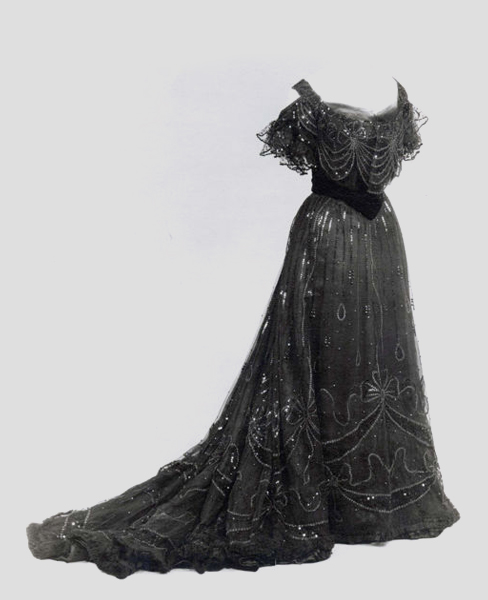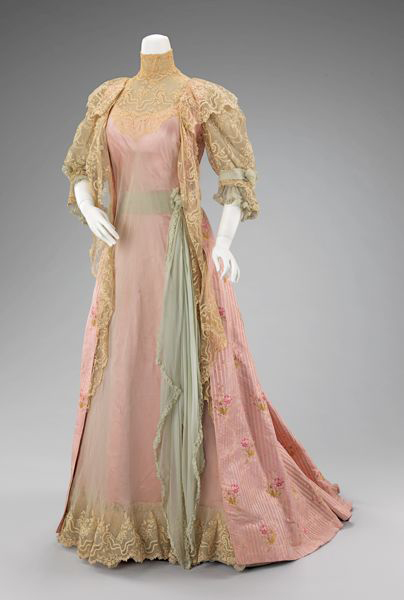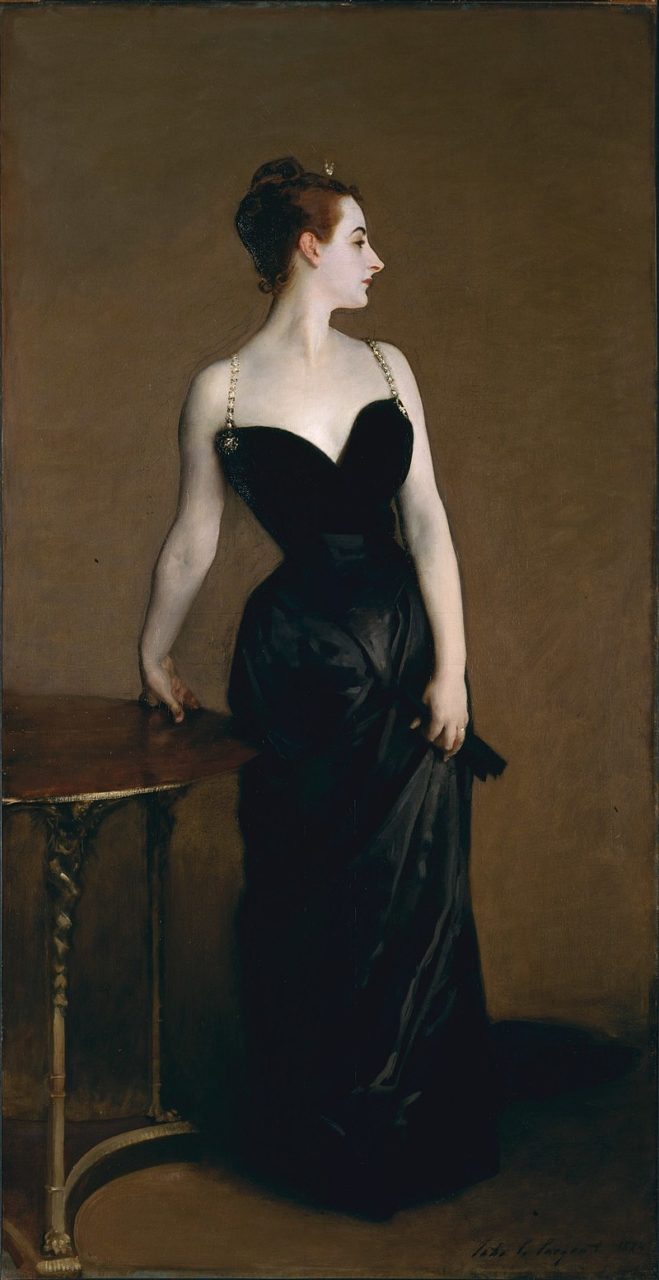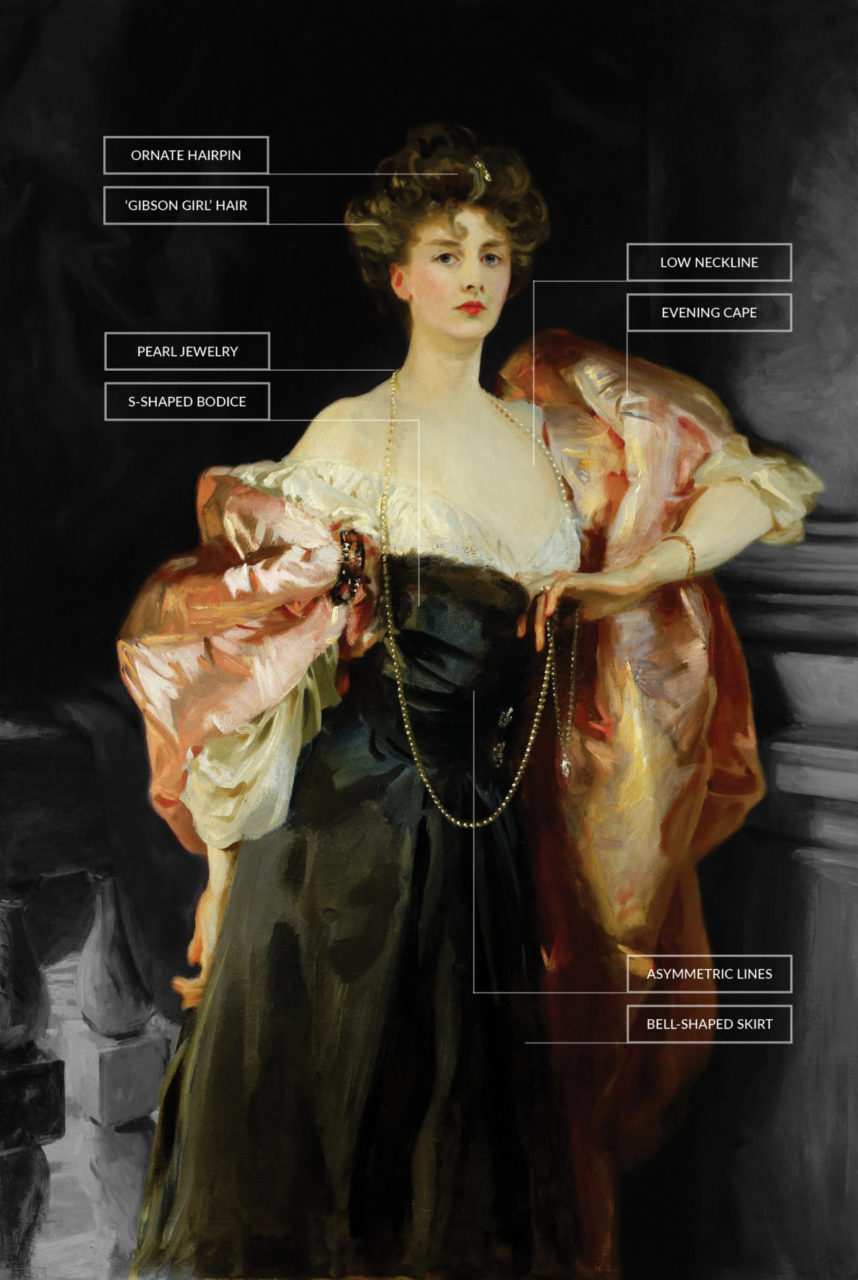Two decades after premiering his most scandalous painting, Madame X, John Singer Sargent unveiled a portrait of another woman known for her unworldly beauty and charm – Lady Helen Vincent, Viscountess D’Abernon.
About the Portrait
Before he was one of the most in demand fashionable portrait painters, John Singer Sargent was an aspiring artist, born in Florence in 1856, from a modest, American family. At age 18, the family moved to Paris so Sargent could study at the atelier of Carolus-Duran, where he was studied masters of art – Diego Velázquez in particular. “The emphasis was on capturing the flow of light on surface, seeking inflections and what was shimmering and in flux rather than solid mass or carefully delineated tonal structure,” writes Colm Tóibín of The Telegraph, in his article “The Secret Life of John Singer Sargent.” Tóibín also notes:
“In 1878, Sargent began to exhibit at the Salon in Paris. He developed a way of making his subjects seem both close and distant. His way of painting a face appeared to capture a vivid sense of life while also managing to depict a fine detachment. His use of costume and pose was highly theatrical.”
Navigating the dynamics not only of Paris, but the well-established Salon, which held its first exhibition in 1667, Sargent was learning how to capture portrait sitters while also developing his own personal style. Many of Sargent’s most celebrated portraits captured members of high society whose world was rapidly shifting, but early on he was also painting his friends. His portraits often have a sense of theatricality to them, along with a masterly depiction of light and fabric, as can be seen in his 1897 painting Mrs. George Swinton (Fig. 1).
Fig. 1 - John Singer Sargent (American, 1856–1925). Mrs. George Swinton (Elizabeth Ebsworth), 1897. Oil on canvas; 231 x 124 cm. Chicago: Art Institute of Chicago, 1922.4450. Wirt D. Walker Collection. Source: AIC
Sargent was intensely cultured – an avid traveler fluent in French, Italian and German – and would frequently visit Venice. This is where he met Lady Helen Vincent, in 1903, a year before her portrait was painted. Lady Helen who’s described as “one of the beauties of the age, and a woman of a rare charm and distinction” was a British socialite and wife of financier and diplomat Sir Edgar Vincent (Ormond, Kilmurray 42). She was also a member of “the Souls”, a salon of intellectual politicians, writers, scientists, and artists, among others. As a trained nurse anaesthetist, Lady Helen would go on to treat thousands of patients during WWI (Wikipedia).
Lady Helen’s official portrait was not the first time under Sargent’s gaze. Many preliminary charcoal sketches were also created (Fig. 2). In their book John Singer Sargent: Venetian Figures and Landscapes (1898-1913), authors Richard Ormond and Elaine Kilmurray provide some insight into Lady Helen Vincent, Viscountess D’Abernon:
“There had been a plan for Sargent to paint portraits of Lady Helen Vincent and her sister, Lady Cynthia Graham. Sargent’s magnificent portrait of Lady Helen Vincent was painted in the Palazzo Giustiniani on the Grand Canal, where she had an apartment. In the portrait, she is shown standing beside a column fingering her pearls, with a vivid glimpse of the Grand Canal through the balustrade at bottom left.” (43)
Fig. 2 - John Singer Sargent (American, 1856–1925). Lady Helen, later Viscountess d'Abernon, 1801-04. Charcoal on paper. YORAG : R2516. Source: York Art Gallery
John Singer Sargent (American, 1856–1925). Lady Helen Vincent, Viscountess D’Abernon, 1904. Oil on canvas; 158.8 x 108 cm (62 1/2 x 42 1/2 in). Birmingham: Birmingham Museum of Art, 1984.121. Source: Birmingham Museum of Art
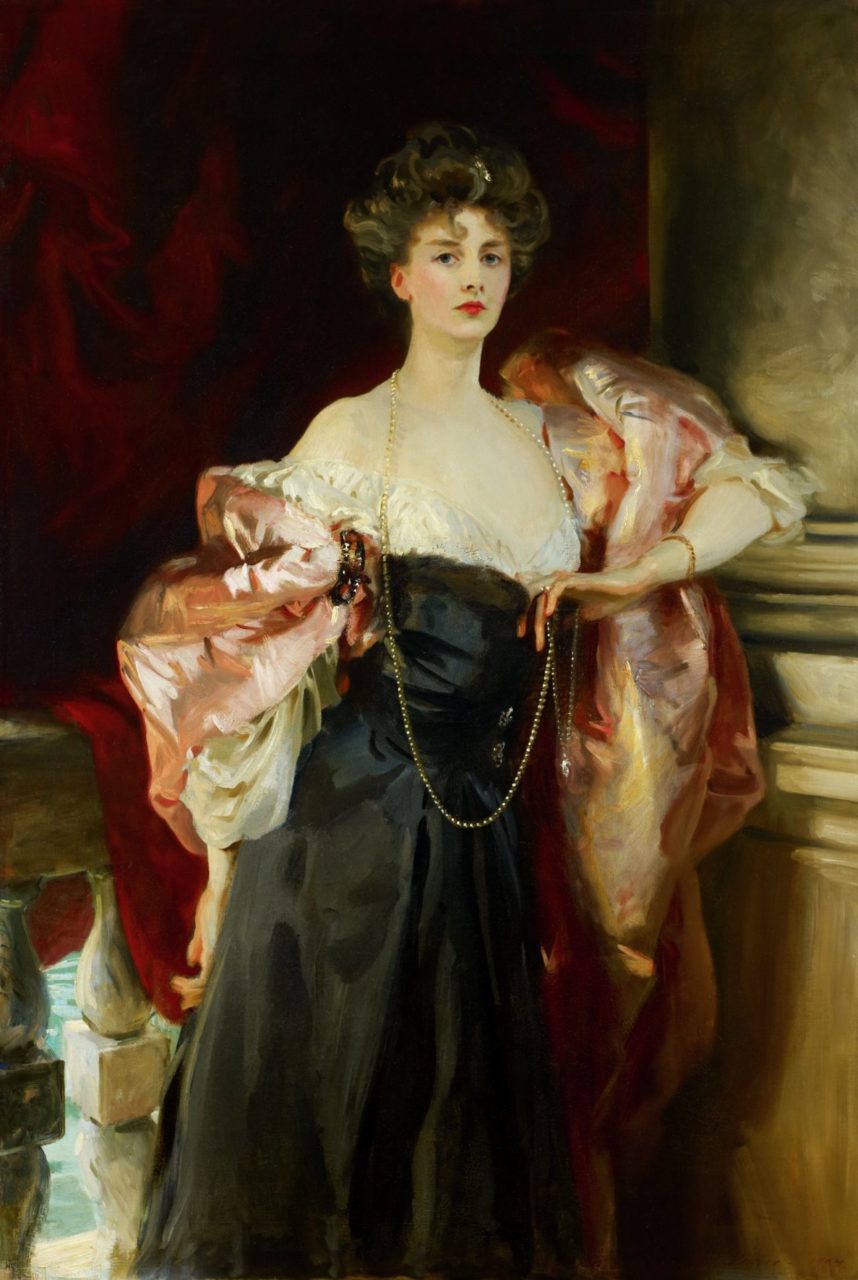
About the Fashion
Painted by Sargent (age 48) in 1904, Lady Helen (37) is seen wearing a highly elegant black satin evening gown, consistent with the Edwardian era (Fig. 3). Susan Brown, editor of Fashion: The Definitive History of Costume and Style outlines the period, often referred to as “La Belle Epoque” or “The Jazz Age”:
“Ladies of the Edwardian era (1901-10), whether young or old, bared their décolletage and upper arms when wearing evening dresses, but encased their lowers arms in long evening gloves. Sumptuous fabrics such as silk satin, damask, and chiffon, usually in light, soft colors, were decorated with lace, rhinestones, and, spangles, often highlighting a part of the body or the face.” (232)
There are two main factors that are reflective of this period – Lady Helen’s low décolletage and her cinched, pigeon-breasted torso, which was achieved by new corsetry introduced in 1900. “The new design had a straight busk, began lower down on the bosom, which it released, and extended more deeply over the hips,” writes Elizabeth Ewing, author of the book History of Twentieth Century Fashion. Ewing also states:
“This corset forced the bosom forward and thrust the hips back, thereby producing what became known as the ‘kangaroo stance’ as well as the ‘S’ line. The fashionable shape therefore consisted of a large, overhanging bust, augmented, if nature was sparing.” (9)
Sometimes called the “health” corset, advertisements promoted this new corsetry as more practical and better for one’s internal organs (Fig. 4), a claim we now know is untrue. As early as 1899, American women were advocating against corsets by forming the “Good Health Club” and arguing that these tight, constricting corsets were causing women to faint in public (Dorsey 103).
Fig. 3 - House of Worth (French, 1858–1956). Evening dress, 1906–8. Silk. New York: The Metropolitan Museum of Art, 37.144.4a–c. Gift of Susan Dwight Bliss, 1937. Source: The Met
Fig. 4 - Artist unknown. Illustration from the Ladies Home Journal, October 1900. Edwardian "s-bend" corseted silhouette. Source: Wikipedia
Considering that most eveningwear in the late 19th- and very early 20th-century consisted of lace, more lace, ruffles, bows, rosettes and a series of embellishments (Figs. 5-8), Lady Helen’s attire is rather refined in its relative lack of decorative detail. As contemporary dresses reflect, in the Edwardian era “natural” colors such as white, black, and light pastels – as seen in Lady Helen’s pink evening dolman – were preferred. There was an emphasis on refinement and taste.
Fig. 5 - Jacques Doucet (French, 1853–1929). Ball Gown, ca. 1902. Silk, metal. New York: The Met, 2009.300.3309a, b. Gift of the Brooklyn Museum, 2009; Gift of Mrs. Frederick H. Prince, Jr., 1967. Source: The Met
Fig. 6 - House of Worth (French, 1858–1956). Tea Gown, 1900–1901. Silk. New York: The Met, 2009.300.2498. Gift of the Brooklyn Museum, 2009; Gift of Mrs. C. Oliver Iselin, 1961. Source: The Met
Fig. 7 - House of Worth (French, 1858–1956). Ball Gown, 1900–1905. Silk, cotton, metallic thread, glass, metal. New York: The Met, 1979.251.4a, b. Gift of Mrs. Walter H. Page, 1979. Source: The Met
Fig. 8 - Charles Klein (French). Evening dress, ca. 1910. Cotton, silk. New York: The Met, 2009.300.1283. Gift of the Brooklyn Museum, 2009; Gift of Mr. and Mrs. Maxime L. Hermanos, 1961. Source: The Met
The few accessories Lady Helen is wearing – pearl necklace and ring, gold bracelet, and adorning hairpin – are also consistent with the time period. “Jewelry changed according to seasons and circumstances. Summer meant no diamonds and other precious stones, but baroque pearls and enamels” (133), writes Hebe Dorsey in Age of Opulence: The Belle Époque in the Paris Herald (1890-1914). “There were also very pretty and practical platinum hairpins, very small and ornamented with diamonds and other stones” (131). While Lady Helen’s blush, or rouge, was common during the late-19th and early-20th centuries, her lip color is more bold than what was considered appropriate (though we can’t be certain if this was an artist addition by Sargent, who we know was heavily involved in his sitter’s wardrobe). Hairstyling, however, was very much a point of attention:
“Hair was puffed out and built up over pads inserted along the front of the head. These were known as ‘rats’ and persisted through the first decade of this century and to some degree after that. The back hair was drawn up and supported by combs” (Ewing 10).
Comparison to Madame X
Sargent’s Lady Helen Vincent, Viscountess D’Abernon has been praised and celebrated by many, but the painting often evokes another emotion, something indescribable, and similar to the feeling one experiences when first viewing Sargent’s most controversial painting – Madame X.
In 1884, when Sargent unveiled Portrait de Mme *** (Fig. 9) at the Paris Salon, it was met with immense curiosity and criticism. The subject, Madame Pierre Gautreau, was a well-known and absolutely stunning American living in Paris. In the portrait, the only thing that covers her ghostly-white skin, is a solid black and strikingly revealing gown. The public reception to the painting was so harsh that Sargent relocated from Paris to London that same year (Ormond, Kilmurray 101).
The events following this scandal provide context to Sargent’s later design choices, particularly Lady Helen Vincent, which was painted two decades after Portrait of Madame X. In Interpreting Sargent, author Elizabeth Prettejohn provides more insight into Madame X:
Fig. 9 - John Singer Sargent (American, 1856–1925). Madame X (Madame Pierre Gautreau), 1883–84. Oil on canvas. New York: The Metropolitan Museum of Art, 16.53. Arthur Hoppock Hearn Fund, 1916. Source: The Metropolitan Museum of Art;
Fig. 10 - John Singer Sargent (American, 1856–1925). Detail of Bodice: Madame X, 1883–84 (Left); Lady Helen Vincent, 1904 (Right). Source: Madame X
Fig. 11 - John Singer Sargent (American, 1856–1925). Detail of Ear: Madame X, 1883–84 (Left); Lady Helen Vincent, 1904 (Right). Source: Madame X
Diagram of referenced dress features.
Source: Author
“As several critics noted, even the dress is painted to seem donned for effect, leaving a gap between the bodice and the body underneath; as the critic for the Revue des deux mondes put it, the bodice ‘seems to flee contact with the flesh’.
But most startling is the uniform whiteness of the make-up, overly artificial mimicry of aristocratic pallor. The conspicuous red ear has been described as an outlandish feature of the real Gautreau’s make-up […].
But the ear also functions as a startling visual reminder of the colour of flesh and blood (Fig. 11), otherwise eliminated from the figure’s artful self-presentation. Moreover, some critics observed that her hair was artificially coloured with henna. For nineteenth-century audiences cosmetics were a contentious issue. Charles Baudelaire’s In Praise of Cosmetics, published in 1863, set out to shock, lauding the artistry of cosmetics for correcting the faults of nature.” (26)
Although there’s no evidence that Lady Helen’s portrait was met with the same amount of criticism as Gautreau’s, both portraits could undoubtedly be described as risqué. Both portraits feature similar plunging black bodices (Fig. 10) and even the same conspicuous red ears (Fig. 11). Both women also lack the evening gloves that were expected in the period. The directness of both women’s sensuality is unapologetically matched with a complex sense of reservation. Pettejohn writes in Interpreting Sargent (1999):
“These physical features describe a sexuality that is cold and remote, under the professional control of the sitter rather than available for the male viewer’s pleasure…This contrasts abruptly with other contemporary portraits of young women.” (26)
Today Sargent is hailed as a pioneer of portrait painting, and his work can be seen internationally. Most recently, the Museum of Fine Arts, Boston announced a major exhibition opening in 2021-22 titled “Sargent and Fashion” (MFA).
References:
- Brown, Susan, ed.. Fashion: The Definitive History of Costume and Style. New York: DK Publishing, 2012. http://www.worldcat.org/oclc/1041708396.
- Dorsey, Hebe. Age of Opulence: The Belle Epoque in the Paris Herald, 1890-1914. New York: Abrams, 1987. http://www.worldcat.org/oclc/185890840.
- Ewing, Elizabeth. History of Twentieth Century Fashion. Rev. ed. Totowa, N.J: Barnes & Noble, 1986. http://www.worldcat.org/oclc/950739076.
- “Exhibition Lab: Sargent and Fashion.” Museum of Fine Arts, Boston, August 20, 2018. https://www.mfa.org/exhibitions/exhibition-lab-sargent-and-fashion.
- “Helen Vincent, Viscountess D’Abernon.” Wikipedia, August 29, 2017. https://en.wikipedia.org/w/index.php?title=Helen_Vincent,_Viscountess_D%27Abernon&oldid=797829313.
- “History of Corsets.” Wikipedia, November 22, 2018. https://en.wikipedia.org/w/index.php?title=History_of_corsets&oldid=870178244.
- Kilmurray, Elaine, Richard Ormond, and Mary Crawford Volk. John Singer Sargent. Princeton: Princeton University Press, 1998. http://www.worldcat.org/oclc/890363004.
- Ormond, Richard, Elaine Kilmurray. John Singer Sargent: Venetian Figures and Landscapes, 1898-1913. Complete Paintings, v. 6. New Haven: Yale University Press, 2009. http://www.worldcat.org/oclc/877277000.
- Prettejohn, Elizabeth. Interpreting Sargent. New York: Stewart, Tabori & Chang, 1999. http://www.worldcat.org/oclc/607093408.
- Ratcliff, Carter. John Singer Sargent. New York : Abbeville Press, 1982. http://www.worldcat.org/oclc/47136691.
- Tóibín, Colm. “The Secret Life of John Singer Sargent.” The Telegraph, July 21, 2015. https://www.telegraph.co.uk/art/artists/the-secret-life-of-john-singer-sargent/.




